Business Law Report: Analysis of UK Business Law and its Applications
VerifiedAdded on 2021/02/22
|13
|4775
|80
Report
AI Summary
This business law report provides a comprehensive overview of the UK legal system as it pertains to businesses. It begins by defining business law and then delves into the concept of parliamentary sovereignty and the sources of law, including customs, common law, European law, and Acts of Parliament. The report then examines the role of the government in the law-making process, detailing the steps involved in enacting legislation. It further explores the potential impact of company, employment, and contract law on business operations, including the implications of the Company Act 2006, contract law principles, and employment regulations. The report also investigates different types of business organizations, differentiating between unincorporated and incorporated businesses and outlining the advantages and disadvantages of partnerships and companies. Finally, the report presents two case studies involving business disputes, offering recommendations for appropriate legal advice based on statutory and common law principles and decided case laws.
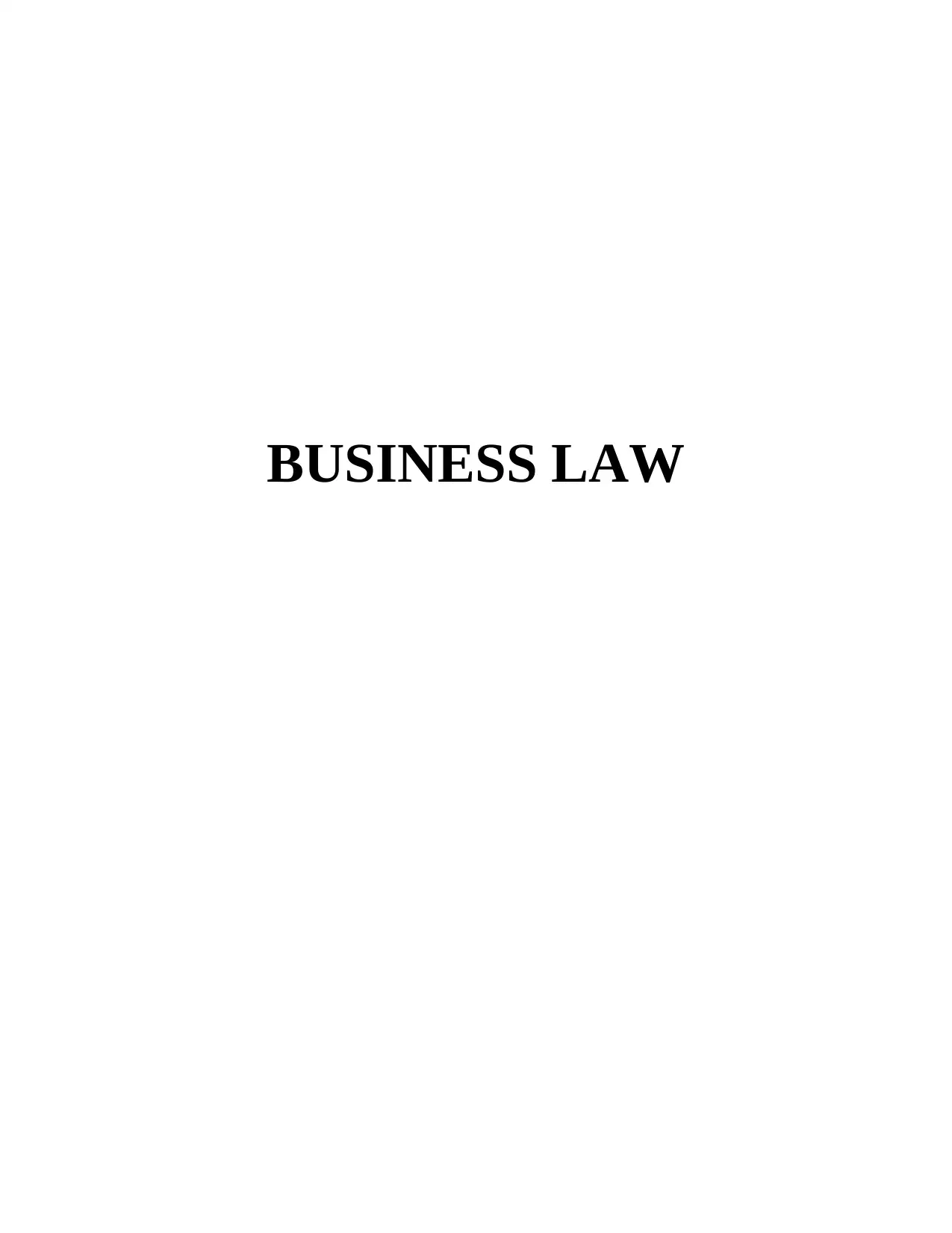
BUSINESS LAW
Paraphrase This Document
Need a fresh take? Get an instant paraphrase of this document with our AI Paraphraser
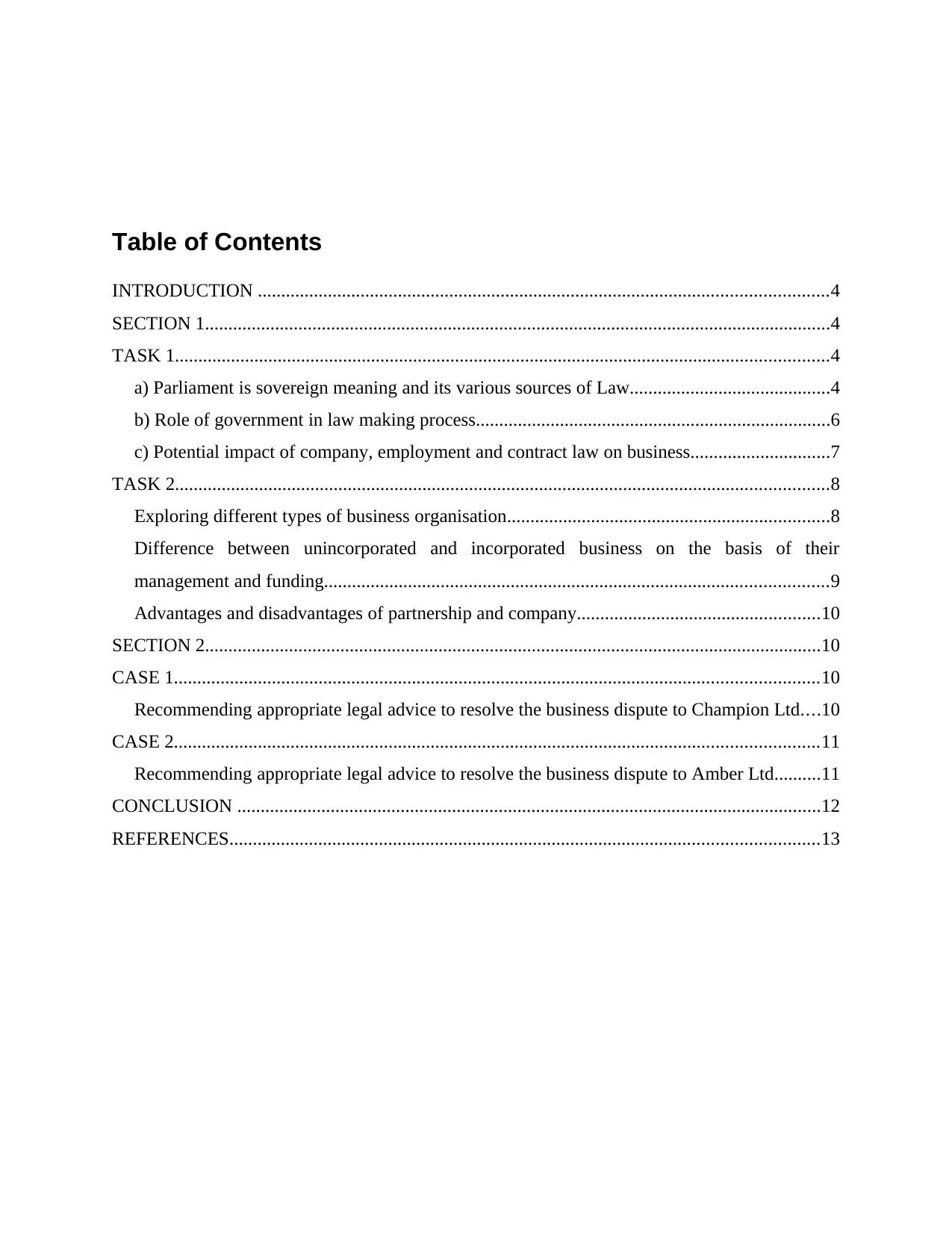
Table of Contents
INTRODUCTION ..........................................................................................................................4
SECTION 1......................................................................................................................................4
TASK 1............................................................................................................................................4
a) Parliament is sovereign meaning and its various sources of Law...........................................4
b) Role of government in law making process............................................................................6
c) Potential impact of company, employment and contract law on business..............................7
TASK 2............................................................................................................................................8
Exploring different types of business organisation.....................................................................8
Difference between unincorporated and incorporated business on the basis of their
management and funding............................................................................................................9
Advantages and disadvantages of partnership and company....................................................10
SECTION 2....................................................................................................................................10
CASE 1..........................................................................................................................................10
Recommending appropriate legal advice to resolve the business dispute to Champion Ltd....10
CASE 2..........................................................................................................................................11
Recommending appropriate legal advice to resolve the business dispute to Amber Ltd..........11
CONCLUSION .............................................................................................................................12
REFERENCES..............................................................................................................................13
INTRODUCTION ..........................................................................................................................4
SECTION 1......................................................................................................................................4
TASK 1............................................................................................................................................4
a) Parliament is sovereign meaning and its various sources of Law...........................................4
b) Role of government in law making process............................................................................6
c) Potential impact of company, employment and contract law on business..............................7
TASK 2............................................................................................................................................8
Exploring different types of business organisation.....................................................................8
Difference between unincorporated and incorporated business on the basis of their
management and funding............................................................................................................9
Advantages and disadvantages of partnership and company....................................................10
SECTION 2....................................................................................................................................10
CASE 1..........................................................................................................................................10
Recommending appropriate legal advice to resolve the business dispute to Champion Ltd....10
CASE 2..........................................................................................................................................11
Recommending appropriate legal advice to resolve the business dispute to Amber Ltd..........11
CONCLUSION .............................................................................................................................12
REFERENCES..............................................................................................................................13
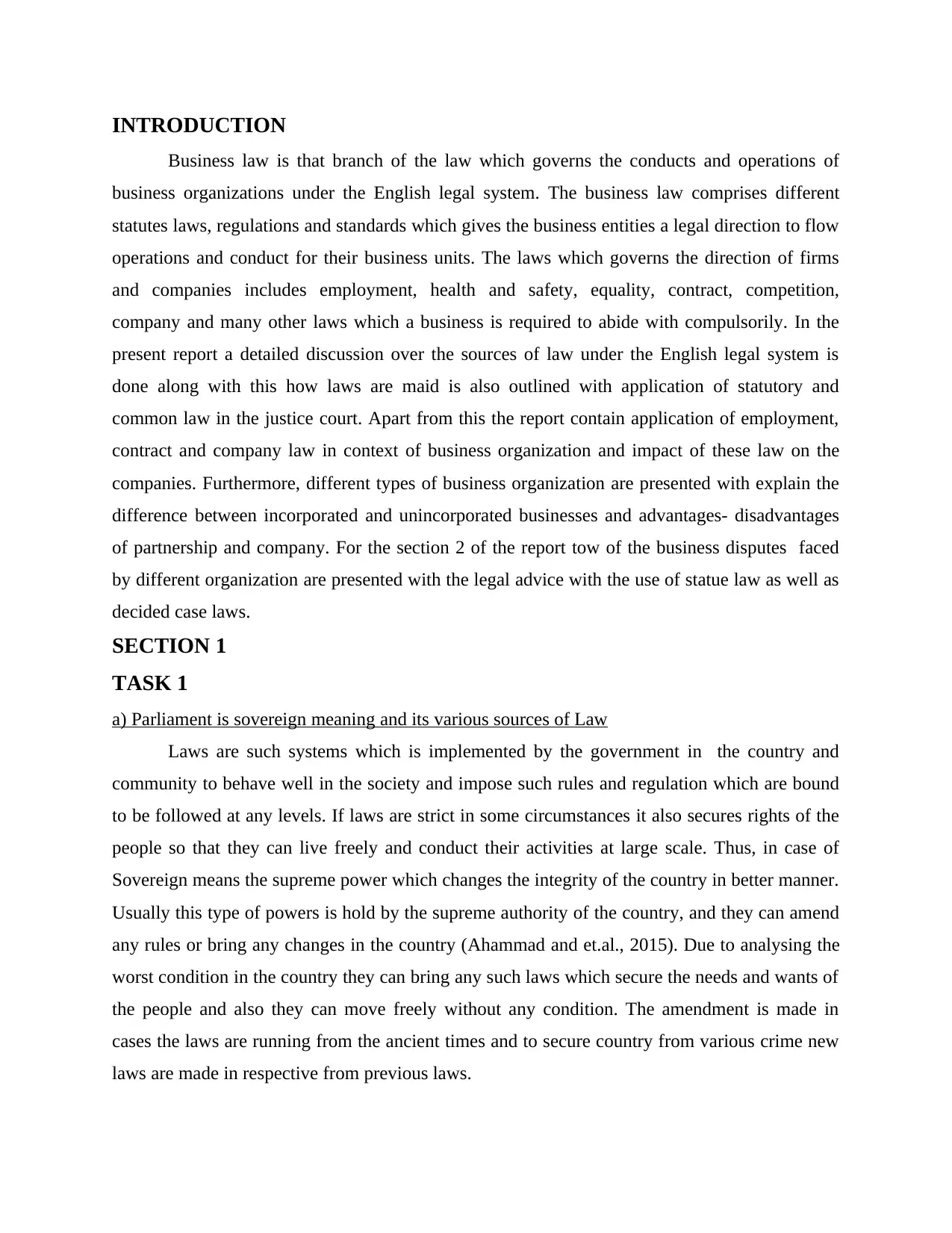
INTRODUCTION
Business law is that branch of the law which governs the conducts and operations of
business organizations under the English legal system. The business law comprises different
statutes laws, regulations and standards which gives the business entities a legal direction to flow
operations and conduct for their business units. The laws which governs the direction of firms
and companies includes employment, health and safety, equality, contract, competition,
company and many other laws which a business is required to abide with compulsorily. In the
present report a detailed discussion over the sources of law under the English legal system is
done along with this how laws are maid is also outlined with application of statutory and
common law in the justice court. Apart from this the report contain application of employment,
contract and company law in context of business organization and impact of these law on the
companies. Furthermore, different types of business organization are presented with explain the
difference between incorporated and unincorporated businesses and advantages- disadvantages
of partnership and company. For the section 2 of the report tow of the business disputes faced
by different organization are presented with the legal advice with the use of statue law as well as
decided case laws.
SECTION 1
TASK 1
a) Parliament is sovereign meaning and its various sources of Law
Laws are such systems which is implemented by the government in the country and
community to behave well in the society and impose such rules and regulation which are bound
to be followed at any levels. If laws are strict in some circumstances it also secures rights of the
people so that they can live freely and conduct their activities at large scale. Thus, in case of
Sovereign means the supreme power which changes the integrity of the country in better manner.
Usually this type of powers is hold by the supreme authority of the country, and they can amend
any rules or bring any changes in the country (Ahammad and et.al., 2015). Due to analysing the
worst condition in the country they can bring any such laws which secure the needs and wants of
the people and also they can move freely without any condition. The amendment is made in
cases the laws are running from the ancient times and to secure country from various crime new
laws are made in respective from previous laws.
Business law is that branch of the law which governs the conducts and operations of
business organizations under the English legal system. The business law comprises different
statutes laws, regulations and standards which gives the business entities a legal direction to flow
operations and conduct for their business units. The laws which governs the direction of firms
and companies includes employment, health and safety, equality, contract, competition,
company and many other laws which a business is required to abide with compulsorily. In the
present report a detailed discussion over the sources of law under the English legal system is
done along with this how laws are maid is also outlined with application of statutory and
common law in the justice court. Apart from this the report contain application of employment,
contract and company law in context of business organization and impact of these law on the
companies. Furthermore, different types of business organization are presented with explain the
difference between incorporated and unincorporated businesses and advantages- disadvantages
of partnership and company. For the section 2 of the report tow of the business disputes faced
by different organization are presented with the legal advice with the use of statue law as well as
decided case laws.
SECTION 1
TASK 1
a) Parliament is sovereign meaning and its various sources of Law
Laws are such systems which is implemented by the government in the country and
community to behave well in the society and impose such rules and regulation which are bound
to be followed at any levels. If laws are strict in some circumstances it also secures rights of the
people so that they can live freely and conduct their activities at large scale. Thus, in case of
Sovereign means the supreme power which changes the integrity of the country in better manner.
Usually this type of powers is hold by the supreme authority of the country, and they can amend
any rules or bring any changes in the country (Ahammad and et.al., 2015). Due to analysing the
worst condition in the country they can bring any such laws which secure the needs and wants of
the people and also they can move freely without any condition. The amendment is made in
cases the laws are running from the ancient times and to secure country from various crime new
laws are made in respective from previous laws.
⊘ This is a preview!⊘
Do you want full access?
Subscribe today to unlock all pages.

Trusted by 1+ million students worldwide
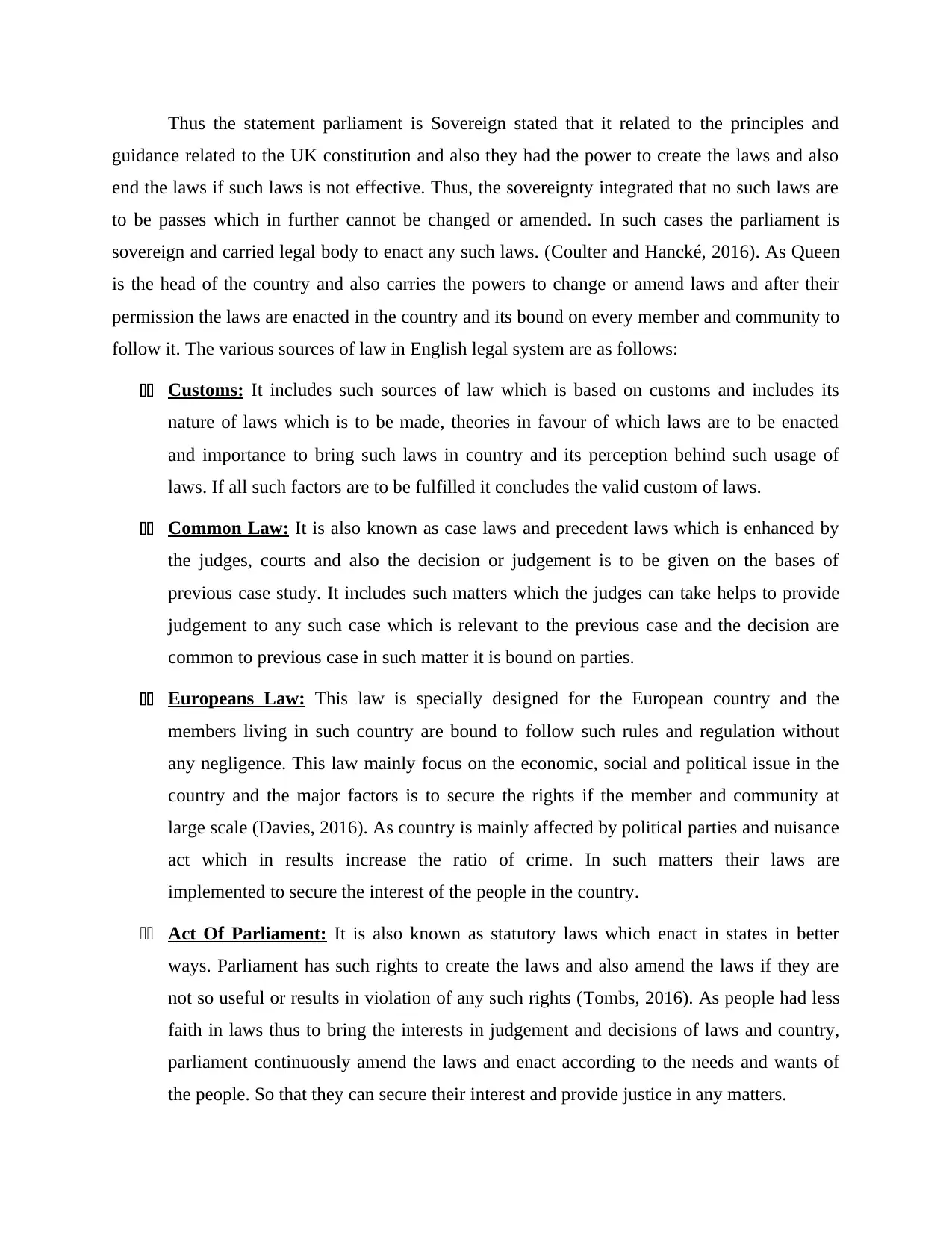
Thus the statement parliament is Sovereign stated that it related to the principles and
guidance related to the UK constitution and also they had the power to create the laws and also
end the laws if such laws is not effective. Thus, the sovereignty integrated that no such laws are
to be passes which in further cannot be changed or amended. In such cases the parliament is
sovereign and carried legal body to enact any such laws. (Coulter and Hancké, 2016). As Queen
is the head of the country and also carries the powers to change or amend laws and after their
permission the laws are enacted in the country and its bound on every member and community to
follow it. The various sources of law in English legal system are as follows:
11 Customs: It includes such sources of law which is based on customs and includes its
nature of laws which is to be made, theories in favour of which laws are to be enacted
and importance to bring such laws in country and its perception behind such usage of
laws. If all such factors are to be fulfilled it concludes the valid custom of laws.
11 Common Law: It is also known as case laws and precedent laws which is enhanced by
the judges, courts and also the decision or judgement is to be given on the bases of
previous case study. It includes such matters which the judges can take helps to provide
judgement to any such case which is relevant to the previous case and the decision are
common to previous case in such matter it is bound on parties.
11 Europeans Law: This law is specially designed for the European country and the
members living in such country are bound to follow such rules and regulation without
any negligence. This law mainly focus on the economic, social and political issue in the
country and the major factors is to secure the rights if the member and community at
large scale (Davies, 2016). As country is mainly affected by political parties and nuisance
act which in results increase the ratio of crime. In such matters their laws are
implemented to secure the interest of the people in the country.
11 Act Of Parliament: It is also known as statutory laws which enact in states in better
ways. Parliament has such rights to create the laws and also amend the laws if they are
not so useful or results in violation of any such rights (Tombs, 2016). As people had less
faith in laws thus to bring the interests in judgement and decisions of laws and country,
parliament continuously amend the laws and enact according to the needs and wants of
the people. So that they can secure their interest and provide justice in any matters.
guidance related to the UK constitution and also they had the power to create the laws and also
end the laws if such laws is not effective. Thus, the sovereignty integrated that no such laws are
to be passes which in further cannot be changed or amended. In such cases the parliament is
sovereign and carried legal body to enact any such laws. (Coulter and Hancké, 2016). As Queen
is the head of the country and also carries the powers to change or amend laws and after their
permission the laws are enacted in the country and its bound on every member and community to
follow it. The various sources of law in English legal system are as follows:
11 Customs: It includes such sources of law which is based on customs and includes its
nature of laws which is to be made, theories in favour of which laws are to be enacted
and importance to bring such laws in country and its perception behind such usage of
laws. If all such factors are to be fulfilled it concludes the valid custom of laws.
11 Common Law: It is also known as case laws and precedent laws which is enhanced by
the judges, courts and also the decision or judgement is to be given on the bases of
previous case study. It includes such matters which the judges can take helps to provide
judgement to any such case which is relevant to the previous case and the decision are
common to previous case in such matter it is bound on parties.
11 Europeans Law: This law is specially designed for the European country and the
members living in such country are bound to follow such rules and regulation without
any negligence. This law mainly focus on the economic, social and political issue in the
country and the major factors is to secure the rights if the member and community at
large scale (Davies, 2016). As country is mainly affected by political parties and nuisance
act which in results increase the ratio of crime. In such matters their laws are
implemented to secure the interest of the people in the country.
11 Act Of Parliament: It is also known as statutory laws which enact in states in better
ways. Parliament has such rights to create the laws and also amend the laws if they are
not so useful or results in violation of any such rights (Tombs, 2016). As people had less
faith in laws thus to bring the interests in judgement and decisions of laws and country,
parliament continuously amend the laws and enact according to the needs and wants of
the people. So that they can secure their interest and provide justice in any matters.
Paraphrase This Document
Need a fresh take? Get an instant paraphrase of this document with our AI Paraphraser
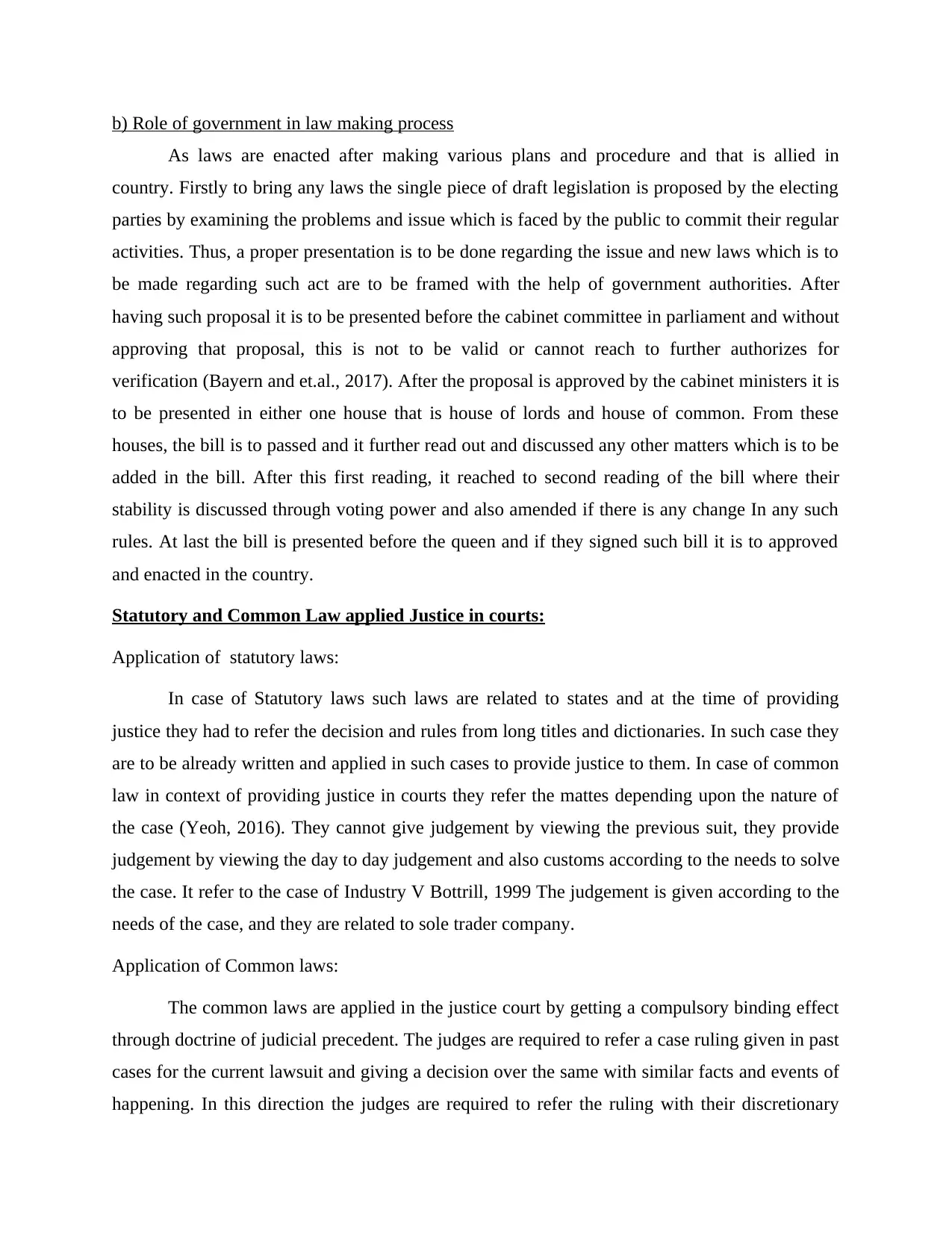
b) Role of government in law making process
As laws are enacted after making various plans and procedure and that is allied in
country. Firstly to bring any laws the single piece of draft legislation is proposed by the electing
parties by examining the problems and issue which is faced by the public to commit their regular
activities. Thus, a proper presentation is to be done regarding the issue and new laws which is to
be made regarding such act are to be framed with the help of government authorities. After
having such proposal it is to be presented before the cabinet committee in parliament and without
approving that proposal, this is not to be valid or cannot reach to further authorizes for
verification (Bayern and et.al., 2017). After the proposal is approved by the cabinet ministers it is
to be presented in either one house that is house of lords and house of common. From these
houses, the bill is to passed and it further read out and discussed any other matters which is to be
added in the bill. After this first reading, it reached to second reading of the bill where their
stability is discussed through voting power and also amended if there is any change In any such
rules. At last the bill is presented before the queen and if they signed such bill it is to approved
and enacted in the country.
Statutory and Common Law applied Justice in courts:
Application of statutory laws:
In case of Statutory laws such laws are related to states and at the time of providing
justice they had to refer the decision and rules from long titles and dictionaries. In such case they
are to be already written and applied in such cases to provide justice to them. In case of common
law in context of providing justice in courts they refer the mattes depending upon the nature of
the case (Yeoh, 2016). They cannot give judgement by viewing the previous suit, they provide
judgement by viewing the day to day judgement and also customs according to the needs to solve
the case. It refer to the case of Industry V Bottrill, 1999 The judgement is given according to the
needs of the case, and they are related to sole trader company.
Application of Common laws:
The common laws are applied in the justice court by getting a compulsory binding effect
through doctrine of judicial precedent. The judges are required to refer a case ruling given in past
cases for the current lawsuit and giving a decision over the same with similar facts and events of
happening. In this direction the judges are required to refer the ruling with their discretionary
As laws are enacted after making various plans and procedure and that is allied in
country. Firstly to bring any laws the single piece of draft legislation is proposed by the electing
parties by examining the problems and issue which is faced by the public to commit their regular
activities. Thus, a proper presentation is to be done regarding the issue and new laws which is to
be made regarding such act are to be framed with the help of government authorities. After
having such proposal it is to be presented before the cabinet committee in parliament and without
approving that proposal, this is not to be valid or cannot reach to further authorizes for
verification (Bayern and et.al., 2017). After the proposal is approved by the cabinet ministers it is
to be presented in either one house that is house of lords and house of common. From these
houses, the bill is to passed and it further read out and discussed any other matters which is to be
added in the bill. After this first reading, it reached to second reading of the bill where their
stability is discussed through voting power and also amended if there is any change In any such
rules. At last the bill is presented before the queen and if they signed such bill it is to approved
and enacted in the country.
Statutory and Common Law applied Justice in courts:
Application of statutory laws:
In case of Statutory laws such laws are related to states and at the time of providing
justice they had to refer the decision and rules from long titles and dictionaries. In such case they
are to be already written and applied in such cases to provide justice to them. In case of common
law in context of providing justice in courts they refer the mattes depending upon the nature of
the case (Yeoh, 2016). They cannot give judgement by viewing the previous suit, they provide
judgement by viewing the day to day judgement and also customs according to the needs to solve
the case. It refer to the case of Industry V Bottrill, 1999 The judgement is given according to the
needs of the case, and they are related to sole trader company.
Application of Common laws:
The common laws are applied in the justice court by getting a compulsory binding effect
through doctrine of judicial precedent. The judges are required to refer a case ruling given in past
cases for the current lawsuit and giving a decision over the same with similar facts and events of
happening. In this direction the judges are required to refer the ruling with their discretionary
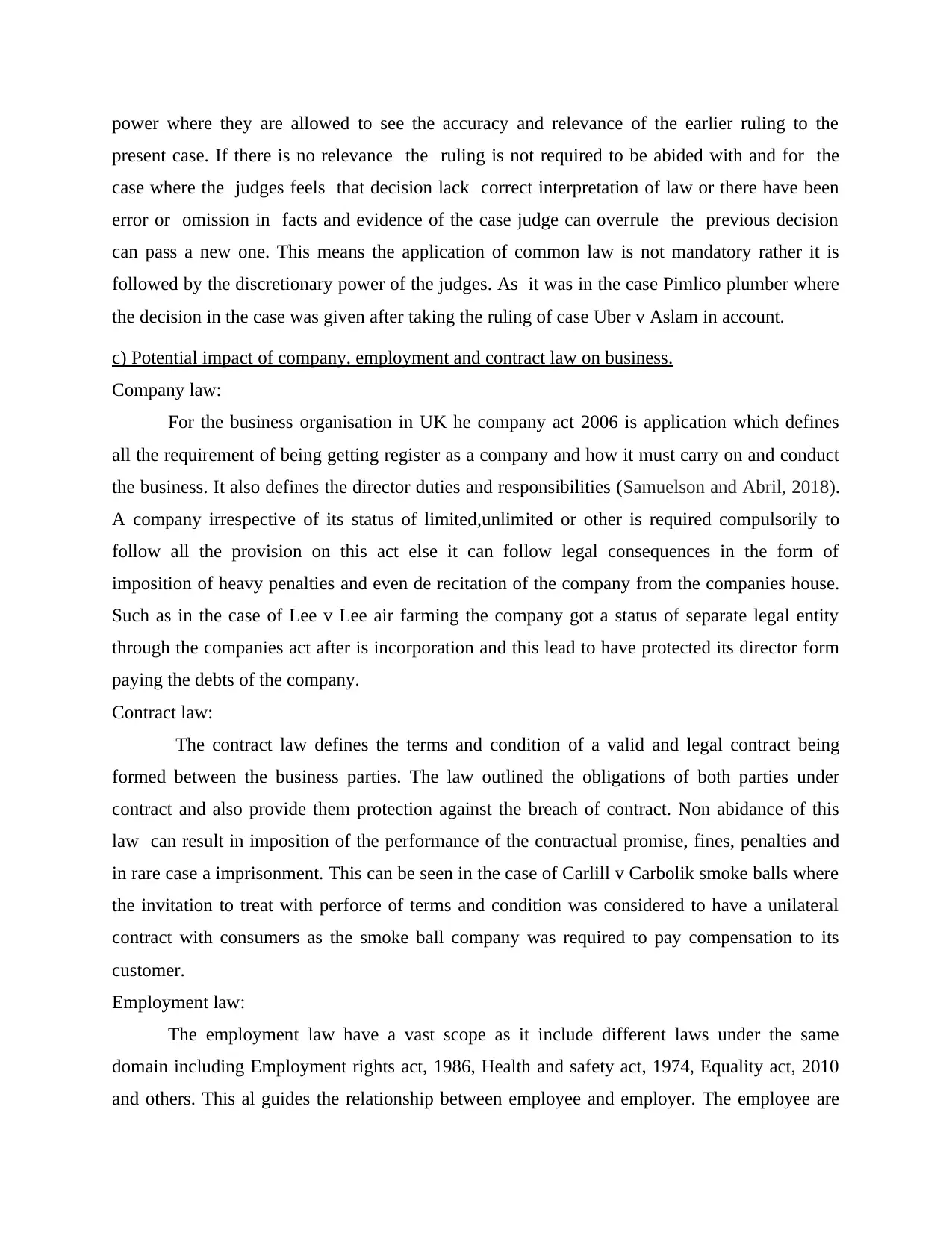
power where they are allowed to see the accuracy and relevance of the earlier ruling to the
present case. If there is no relevance the ruling is not required to be abided with and for the
case where the judges feels that decision lack correct interpretation of law or there have been
error or omission in facts and evidence of the case judge can overrule the previous decision
can pass a new one. This means the application of common law is not mandatory rather it is
followed by the discretionary power of the judges. As it was in the case Pimlico plumber where
the decision in the case was given after taking the ruling of case Uber v Aslam in account.
c) Potential impact of company, employment and contract law on business.
Company law:
For the business organisation in UK he company act 2006 is application which defines
all the requirement of being getting register as a company and how it must carry on and conduct
the business. It also defines the director duties and responsibilities (Samuelson and Abril, 2018).
A company irrespective of its status of limited,unlimited or other is required compulsorily to
follow all the provision on this act else it can follow legal consequences in the form of
imposition of heavy penalties and even de recitation of the company from the companies house.
Such as in the case of Lee v Lee air farming the company got a status of separate legal entity
through the companies act after is incorporation and this lead to have protected its director form
paying the debts of the company.
Contract law:
The contract law defines the terms and condition of a valid and legal contract being
formed between the business parties. The law outlined the obligations of both parties under
contract and also provide them protection against the breach of contract. Non abidance of this
law can result in imposition of the performance of the contractual promise, fines, penalties and
in rare case a imprisonment. This can be seen in the case of Carlill v Carbolik smoke balls where
the invitation to treat with perforce of terms and condition was considered to have a unilateral
contract with consumers as the smoke ball company was required to pay compensation to its
customer.
Employment law:
The employment law have a vast scope as it include different laws under the same
domain including Employment rights act, 1986, Health and safety act, 1974, Equality act, 2010
and others. This al guides the relationship between employee and employer. The employee are
present case. If there is no relevance the ruling is not required to be abided with and for the
case where the judges feels that decision lack correct interpretation of law or there have been
error or omission in facts and evidence of the case judge can overrule the previous decision
can pass a new one. This means the application of common law is not mandatory rather it is
followed by the discretionary power of the judges. As it was in the case Pimlico plumber where
the decision in the case was given after taking the ruling of case Uber v Aslam in account.
c) Potential impact of company, employment and contract law on business.
Company law:
For the business organisation in UK he company act 2006 is application which defines
all the requirement of being getting register as a company and how it must carry on and conduct
the business. It also defines the director duties and responsibilities (Samuelson and Abril, 2018).
A company irrespective of its status of limited,unlimited or other is required compulsorily to
follow all the provision on this act else it can follow legal consequences in the form of
imposition of heavy penalties and even de recitation of the company from the companies house.
Such as in the case of Lee v Lee air farming the company got a status of separate legal entity
through the companies act after is incorporation and this lead to have protected its director form
paying the debts of the company.
Contract law:
The contract law defines the terms and condition of a valid and legal contract being
formed between the business parties. The law outlined the obligations of both parties under
contract and also provide them protection against the breach of contract. Non abidance of this
law can result in imposition of the performance of the contractual promise, fines, penalties and
in rare case a imprisonment. This can be seen in the case of Carlill v Carbolik smoke balls where
the invitation to treat with perforce of terms and condition was considered to have a unilateral
contract with consumers as the smoke ball company was required to pay compensation to its
customer.
Employment law:
The employment law have a vast scope as it include different laws under the same
domain including Employment rights act, 1986, Health and safety act, 1974, Equality act, 2010
and others. This al guides the relationship between employee and employer. The employee are
⊘ This is a preview!⊘
Do you want full access?
Subscribe today to unlock all pages.

Trusted by 1+ million students worldwide
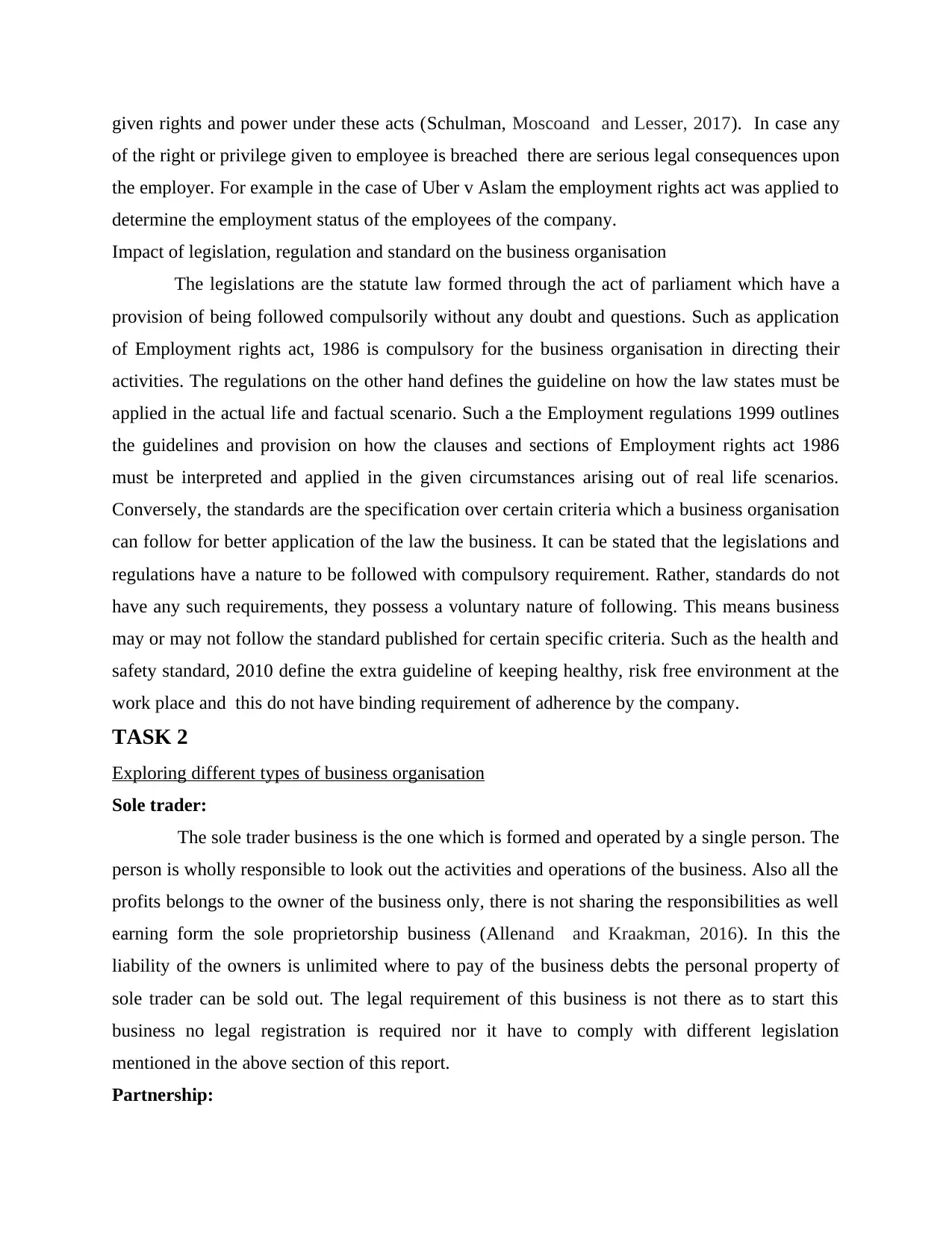
given rights and power under these acts (Schulman, Moscoand and Lesser, 2017). In case any
of the right or privilege given to employee is breached there are serious legal consequences upon
the employer. For example in the case of Uber v Aslam the employment rights act was applied to
determine the employment status of the employees of the company.
Impact of legislation, regulation and standard on the business organisation
The legislations are the statute law formed through the act of parliament which have a
provision of being followed compulsorily without any doubt and questions. Such as application
of Employment rights act, 1986 is compulsory for the business organisation in directing their
activities. The regulations on the other hand defines the guideline on how the law states must be
applied in the actual life and factual scenario. Such a the Employment regulations 1999 outlines
the guidelines and provision on how the clauses and sections of Employment rights act 1986
must be interpreted and applied in the given circumstances arising out of real life scenarios.
Conversely, the standards are the specification over certain criteria which a business organisation
can follow for better application of the law the business. It can be stated that the legislations and
regulations have a nature to be followed with compulsory requirement. Rather, standards do not
have any such requirements, they possess a voluntary nature of following. This means business
may or may not follow the standard published for certain specific criteria. Such as the health and
safety standard, 2010 define the extra guideline of keeping healthy, risk free environment at the
work place and this do not have binding requirement of adherence by the company.
TASK 2
Exploring different types of business organisation
Sole trader:
The sole trader business is the one which is formed and operated by a single person. The
person is wholly responsible to look out the activities and operations of the business. Also all the
profits belongs to the owner of the business only, there is not sharing the responsibilities as well
earning form the sole proprietorship business (Allenand and Kraakman, 2016). In this the
liability of the owners is unlimited where to pay of the business debts the personal property of
sole trader can be sold out. The legal requirement of this business is not there as to start this
business no legal registration is required nor it have to comply with different legislation
mentioned in the above section of this report.
Partnership:
of the right or privilege given to employee is breached there are serious legal consequences upon
the employer. For example in the case of Uber v Aslam the employment rights act was applied to
determine the employment status of the employees of the company.
Impact of legislation, regulation and standard on the business organisation
The legislations are the statute law formed through the act of parliament which have a
provision of being followed compulsorily without any doubt and questions. Such as application
of Employment rights act, 1986 is compulsory for the business organisation in directing their
activities. The regulations on the other hand defines the guideline on how the law states must be
applied in the actual life and factual scenario. Such a the Employment regulations 1999 outlines
the guidelines and provision on how the clauses and sections of Employment rights act 1986
must be interpreted and applied in the given circumstances arising out of real life scenarios.
Conversely, the standards are the specification over certain criteria which a business organisation
can follow for better application of the law the business. It can be stated that the legislations and
regulations have a nature to be followed with compulsory requirement. Rather, standards do not
have any such requirements, they possess a voluntary nature of following. This means business
may or may not follow the standard published for certain specific criteria. Such as the health and
safety standard, 2010 define the extra guideline of keeping healthy, risk free environment at the
work place and this do not have binding requirement of adherence by the company.
TASK 2
Exploring different types of business organisation
Sole trader:
The sole trader business is the one which is formed and operated by a single person. The
person is wholly responsible to look out the activities and operations of the business. Also all the
profits belongs to the owner of the business only, there is not sharing the responsibilities as well
earning form the sole proprietorship business (Allenand and Kraakman, 2016). In this the
liability of the owners is unlimited where to pay of the business debts the personal property of
sole trader can be sold out. The legal requirement of this business is not there as to start this
business no legal registration is required nor it have to comply with different legislation
mentioned in the above section of this report.
Partnership:
Paraphrase This Document
Need a fresh take? Get an instant paraphrase of this document with our AI Paraphraser
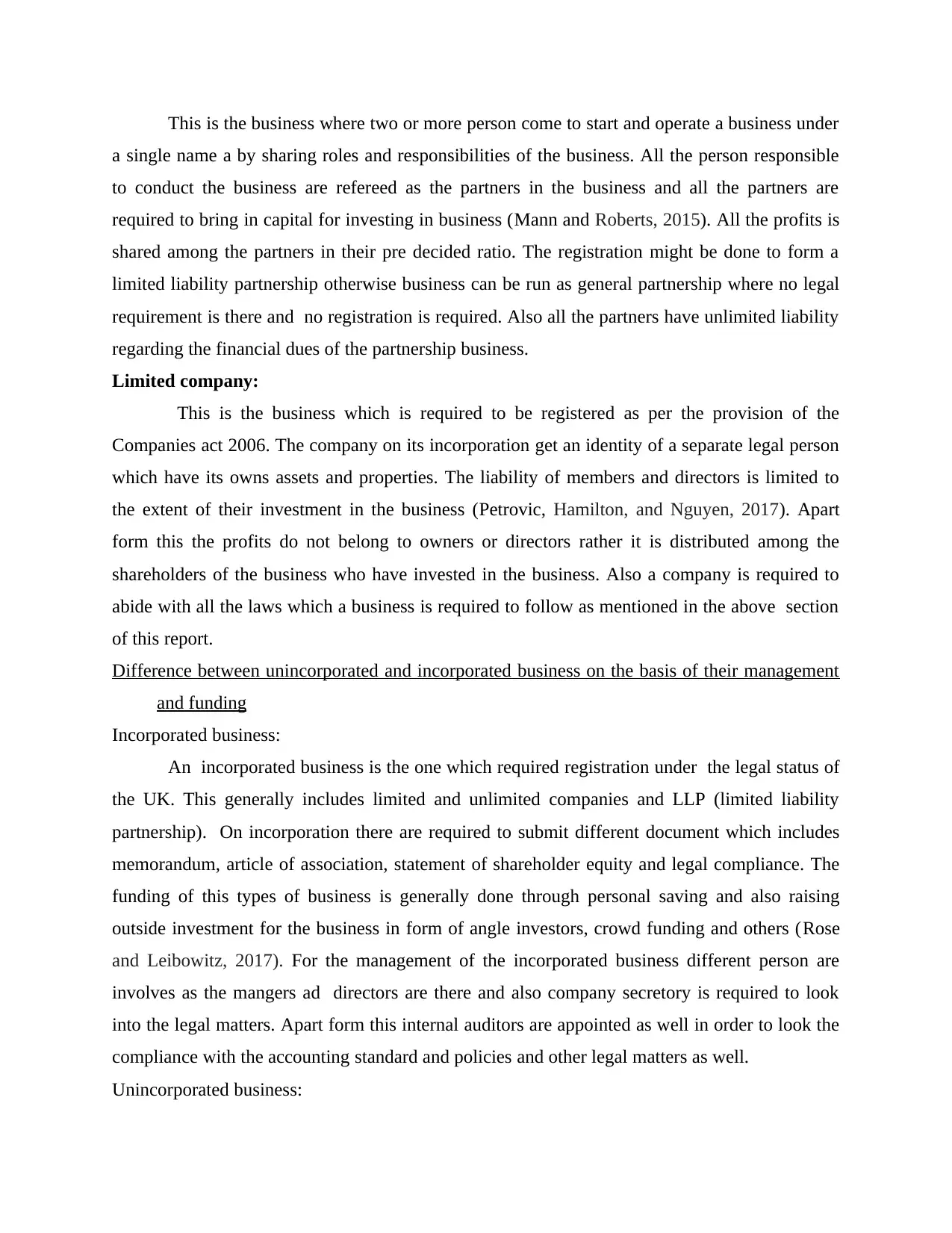
This is the business where two or more person come to start and operate a business under
a single name a by sharing roles and responsibilities of the business. All the person responsible
to conduct the business are refereed as the partners in the business and all the partners are
required to bring in capital for investing in business (Mann and Roberts, 2015). All the profits is
shared among the partners in their pre decided ratio. The registration might be done to form a
limited liability partnership otherwise business can be run as general partnership where no legal
requirement is there and no registration is required. Also all the partners have unlimited liability
regarding the financial dues of the partnership business.
Limited company:
This is the business which is required to be registered as per the provision of the
Companies act 2006. The company on its incorporation get an identity of a separate legal person
which have its owns assets and properties. The liability of members and directors is limited to
the extent of their investment in the business (Petrovic, Hamilton, and Nguyen, 2017). Apart
form this the profits do not belong to owners or directors rather it is distributed among the
shareholders of the business who have invested in the business. Also a company is required to
abide with all the laws which a business is required to follow as mentioned in the above section
of this report.
Difference between unincorporated and incorporated business on the basis of their management
and funding
Incorporated business:
An incorporated business is the one which required registration under the legal status of
the UK. This generally includes limited and unlimited companies and LLP (limited liability
partnership). On incorporation there are required to submit different document which includes
memorandum, article of association, statement of shareholder equity and legal compliance. The
funding of this types of business is generally done through personal saving and also raising
outside investment for the business in form of angle investors, crowd funding and others (Rose
and Leibowitz, 2017). For the management of the incorporated business different person are
involves as the mangers ad directors are there and also company secretory is required to look
into the legal matters. Apart form this internal auditors are appointed as well in order to look the
compliance with the accounting standard and policies and other legal matters as well.
Unincorporated business:
a single name a by sharing roles and responsibilities of the business. All the person responsible
to conduct the business are refereed as the partners in the business and all the partners are
required to bring in capital for investing in business (Mann and Roberts, 2015). All the profits is
shared among the partners in their pre decided ratio. The registration might be done to form a
limited liability partnership otherwise business can be run as general partnership where no legal
requirement is there and no registration is required. Also all the partners have unlimited liability
regarding the financial dues of the partnership business.
Limited company:
This is the business which is required to be registered as per the provision of the
Companies act 2006. The company on its incorporation get an identity of a separate legal person
which have its owns assets and properties. The liability of members and directors is limited to
the extent of their investment in the business (Petrovic, Hamilton, and Nguyen, 2017). Apart
form this the profits do not belong to owners or directors rather it is distributed among the
shareholders of the business who have invested in the business. Also a company is required to
abide with all the laws which a business is required to follow as mentioned in the above section
of this report.
Difference between unincorporated and incorporated business on the basis of their management
and funding
Incorporated business:
An incorporated business is the one which required registration under the legal status of
the UK. This generally includes limited and unlimited companies and LLP (limited liability
partnership). On incorporation there are required to submit different document which includes
memorandum, article of association, statement of shareholder equity and legal compliance. The
funding of this types of business is generally done through personal saving and also raising
outside investment for the business in form of angle investors, crowd funding and others (Rose
and Leibowitz, 2017). For the management of the incorporated business different person are
involves as the mangers ad directors are there and also company secretory is required to look
into the legal matters. Apart form this internal auditors are appointed as well in order to look the
compliance with the accounting standard and policies and other legal matters as well.
Unincorporated business:
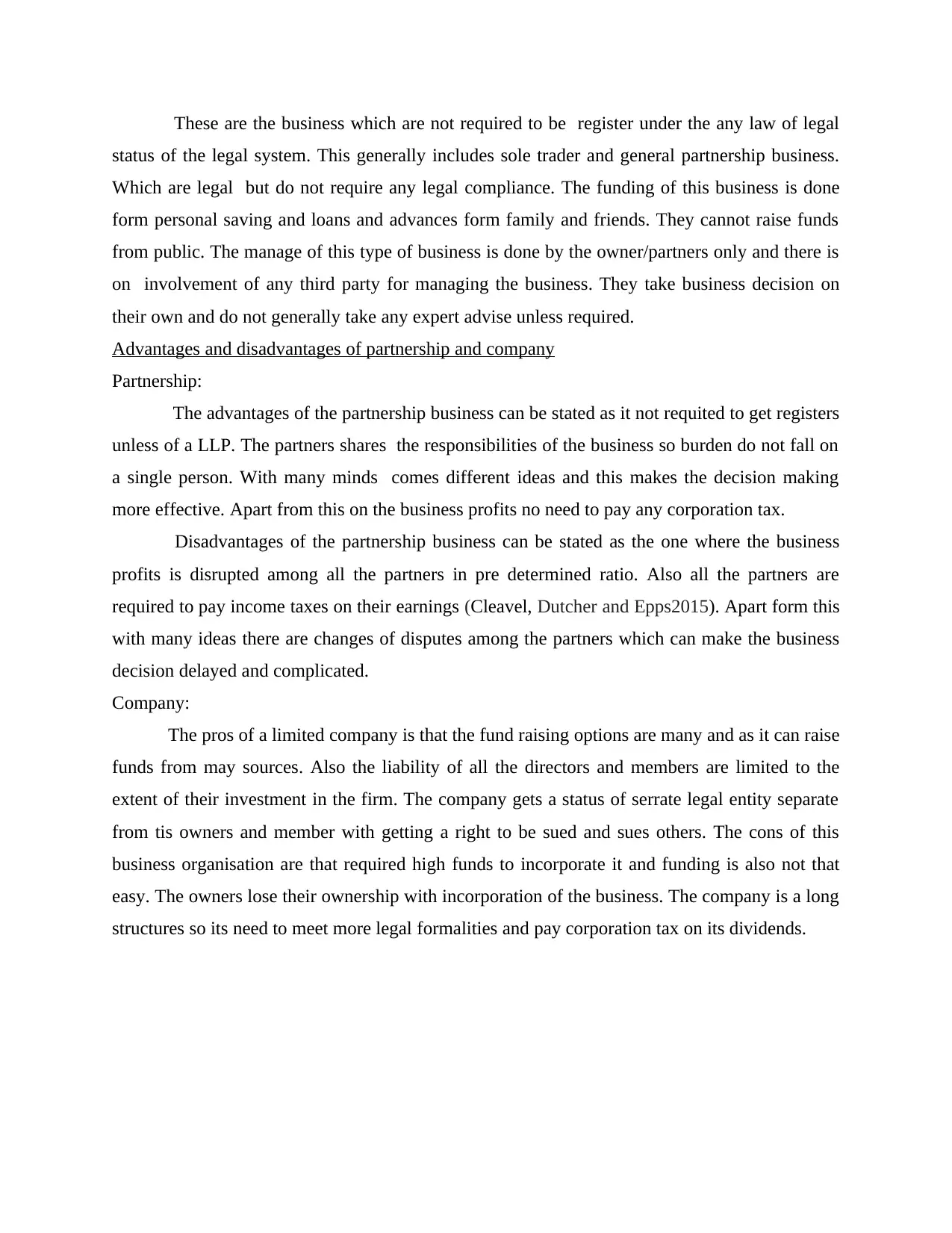
These are the business which are not required to be register under the any law of legal
status of the legal system. This generally includes sole trader and general partnership business.
Which are legal but do not require any legal compliance. The funding of this business is done
form personal saving and loans and advances form family and friends. They cannot raise funds
from public. The manage of this type of business is done by the owner/partners only and there is
on involvement of any third party for managing the business. They take business decision on
their own and do not generally take any expert advise unless required.
Advantages and disadvantages of partnership and company
Partnership:
The advantages of the partnership business can be stated as it not requited to get registers
unless of a LLP. The partners shares the responsibilities of the business so burden do not fall on
a single person. With many minds comes different ideas and this makes the decision making
more effective. Apart from this on the business profits no need to pay any corporation tax.
Disadvantages of the partnership business can be stated as the one where the business
profits is disrupted among all the partners in pre determined ratio. Also all the partners are
required to pay income taxes on their earnings (Cleavel, Dutcher and Epps2015). Apart form this
with many ideas there are changes of disputes among the partners which can make the business
decision delayed and complicated.
Company:
The pros of a limited company is that the fund raising options are many and as it can raise
funds from may sources. Also the liability of all the directors and members are limited to the
extent of their investment in the firm. The company gets a status of serrate legal entity separate
from tis owners and member with getting a right to be sued and sues others. The cons of this
business organisation are that required high funds to incorporate it and funding is also not that
easy. The owners lose their ownership with incorporation of the business. The company is a long
structures so its need to meet more legal formalities and pay corporation tax on its dividends.
status of the legal system. This generally includes sole trader and general partnership business.
Which are legal but do not require any legal compliance. The funding of this business is done
form personal saving and loans and advances form family and friends. They cannot raise funds
from public. The manage of this type of business is done by the owner/partners only and there is
on involvement of any third party for managing the business. They take business decision on
their own and do not generally take any expert advise unless required.
Advantages and disadvantages of partnership and company
Partnership:
The advantages of the partnership business can be stated as it not requited to get registers
unless of a LLP. The partners shares the responsibilities of the business so burden do not fall on
a single person. With many minds comes different ideas and this makes the decision making
more effective. Apart from this on the business profits no need to pay any corporation tax.
Disadvantages of the partnership business can be stated as the one where the business
profits is disrupted among all the partners in pre determined ratio. Also all the partners are
required to pay income taxes on their earnings (Cleavel, Dutcher and Epps2015). Apart form this
with many ideas there are changes of disputes among the partners which can make the business
decision delayed and complicated.
Company:
The pros of a limited company is that the fund raising options are many and as it can raise
funds from may sources. Also the liability of all the directors and members are limited to the
extent of their investment in the firm. The company gets a status of serrate legal entity separate
from tis owners and member with getting a right to be sued and sues others. The cons of this
business organisation are that required high funds to incorporate it and funding is also not that
easy. The owners lose their ownership with incorporation of the business. The company is a long
structures so its need to meet more legal formalities and pay corporation tax on its dividends.
⊘ This is a preview!⊘
Do you want full access?
Subscribe today to unlock all pages.

Trusted by 1+ million students worldwide
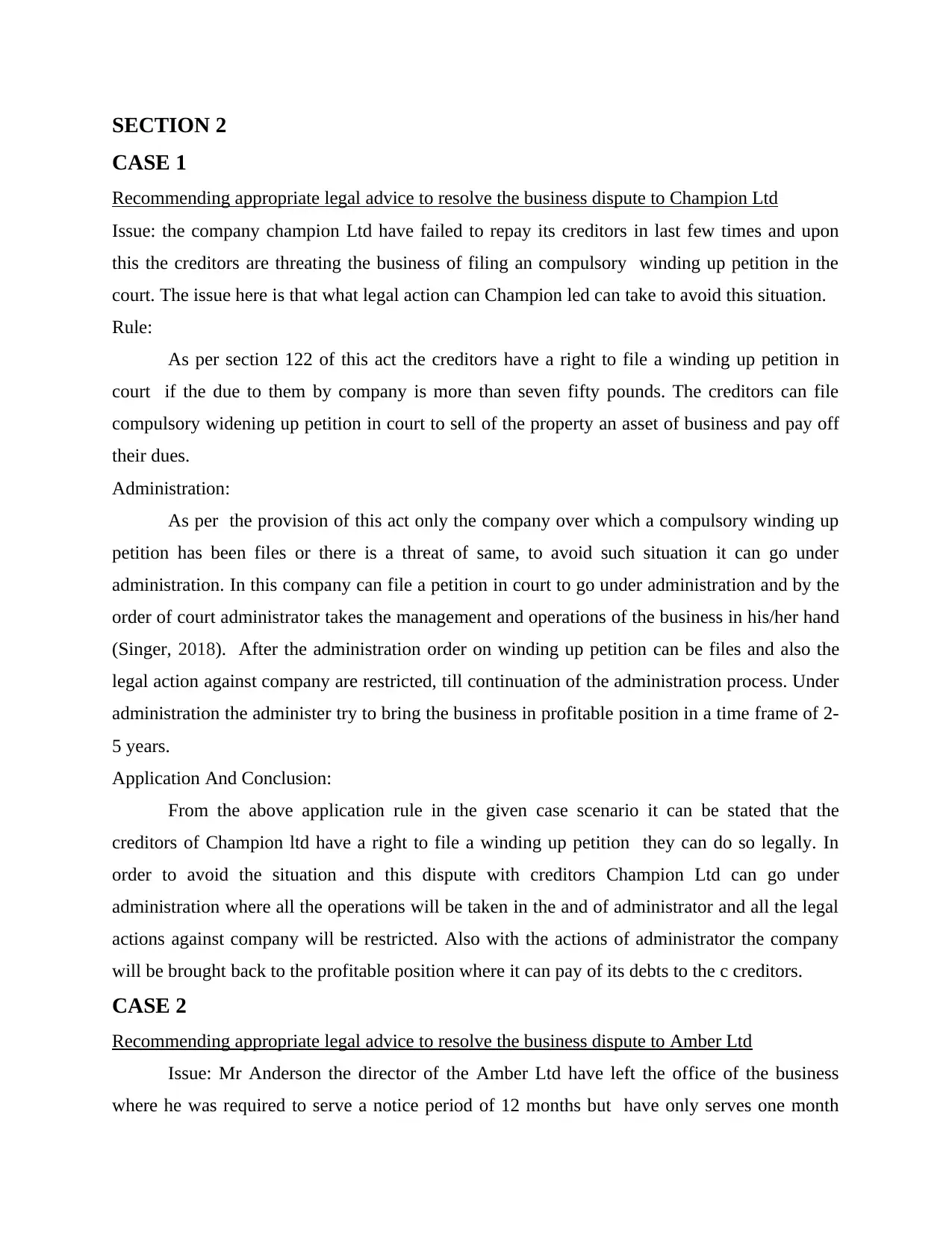
SECTION 2
CASE 1
Recommending appropriate legal advice to resolve the business dispute to Champion Ltd
Issue: the company champion Ltd have failed to repay its creditors in last few times and upon
this the creditors are threating the business of filing an compulsory winding up petition in the
court. The issue here is that what legal action can Champion led can take to avoid this situation.
Rule:
As per section 122 of this act the creditors have a right to file a winding up petition in
court if the due to them by company is more than seven fifty pounds. The creditors can file
compulsory widening up petition in court to sell of the property an asset of business and pay off
their dues.
Administration:
As per the provision of this act only the company over which a compulsory winding up
petition has been files or there is a threat of same, to avoid such situation it can go under
administration. In this company can file a petition in court to go under administration and by the
order of court administrator takes the management and operations of the business in his/her hand
(Singer, 2018). After the administration order on winding up petition can be files and also the
legal action against company are restricted, till continuation of the administration process. Under
administration the administer try to bring the business in profitable position in a time frame of 2-
5 years.
Application And Conclusion:
From the above application rule in the given case scenario it can be stated that the
creditors of Champion ltd have a right to file a winding up petition they can do so legally. In
order to avoid the situation and this dispute with creditors Champion Ltd can go under
administration where all the operations will be taken in the and of administrator and all the legal
actions against company will be restricted. Also with the actions of administrator the company
will be brought back to the profitable position where it can pay of its debts to the c creditors.
CASE 2
Recommending appropriate legal advice to resolve the business dispute to Amber Ltd
Issue: Mr Anderson the director of the Amber Ltd have left the office of the business
where he was required to serve a notice period of 12 months but have only serves one month
CASE 1
Recommending appropriate legal advice to resolve the business dispute to Champion Ltd
Issue: the company champion Ltd have failed to repay its creditors in last few times and upon
this the creditors are threating the business of filing an compulsory winding up petition in the
court. The issue here is that what legal action can Champion led can take to avoid this situation.
Rule:
As per section 122 of this act the creditors have a right to file a winding up petition in
court if the due to them by company is more than seven fifty pounds. The creditors can file
compulsory widening up petition in court to sell of the property an asset of business and pay off
their dues.
Administration:
As per the provision of this act only the company over which a compulsory winding up
petition has been files or there is a threat of same, to avoid such situation it can go under
administration. In this company can file a petition in court to go under administration and by the
order of court administrator takes the management and operations of the business in his/her hand
(Singer, 2018). After the administration order on winding up petition can be files and also the
legal action against company are restricted, till continuation of the administration process. Under
administration the administer try to bring the business in profitable position in a time frame of 2-
5 years.
Application And Conclusion:
From the above application rule in the given case scenario it can be stated that the
creditors of Champion ltd have a right to file a winding up petition they can do so legally. In
order to avoid the situation and this dispute with creditors Champion Ltd can go under
administration where all the operations will be taken in the and of administrator and all the legal
actions against company will be restricted. Also with the actions of administrator the company
will be brought back to the profitable position where it can pay of its debts to the c creditors.
CASE 2
Recommending appropriate legal advice to resolve the business dispute to Amber Ltd
Issue: Mr Anderson the director of the Amber Ltd have left the office of the business
where he was required to serve a notice period of 12 months but have only serves one month
Paraphrase This Document
Need a fresh take? Get an instant paraphrase of this document with our AI Paraphraser
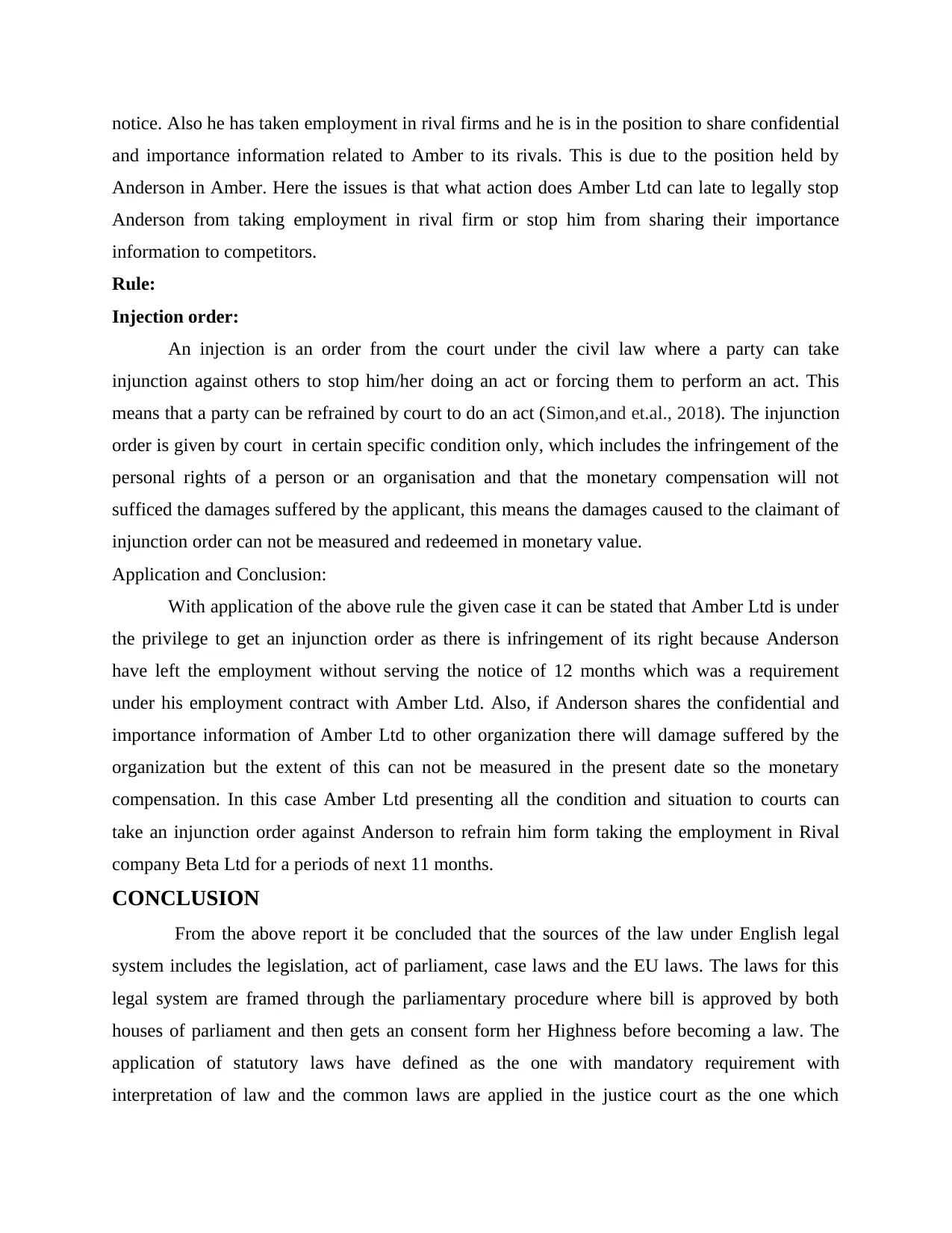
notice. Also he has taken employment in rival firms and he is in the position to share confidential
and importance information related to Amber to its rivals. This is due to the position held by
Anderson in Amber. Here the issues is that what action does Amber Ltd can late to legally stop
Anderson from taking employment in rival firm or stop him from sharing their importance
information to competitors.
Rule:
Injection order:
An injection is an order from the court under the civil law where a party can take
injunction against others to stop him/her doing an act or forcing them to perform an act. This
means that a party can be refrained by court to do an act (Simon,and et.al., 2018). The injunction
order is given by court in certain specific condition only, which includes the infringement of the
personal rights of a person or an organisation and that the monetary compensation will not
sufficed the damages suffered by the applicant, this means the damages caused to the claimant of
injunction order can not be measured and redeemed in monetary value.
Application and Conclusion:
With application of the above rule the given case it can be stated that Amber Ltd is under
the privilege to get an injunction order as there is infringement of its right because Anderson
have left the employment without serving the notice of 12 months which was a requirement
under his employment contract with Amber Ltd. Also, if Anderson shares the confidential and
importance information of Amber Ltd to other organization there will damage suffered by the
organization but the extent of this can not be measured in the present date so the monetary
compensation. In this case Amber Ltd presenting all the condition and situation to courts can
take an injunction order against Anderson to refrain him form taking the employment in Rival
company Beta Ltd for a periods of next 11 months.
CONCLUSION
From the above report it be concluded that the sources of the law under English legal
system includes the legislation, act of parliament, case laws and the EU laws. The laws for this
legal system are framed through the parliamentary procedure where bill is approved by both
houses of parliament and then gets an consent form her Highness before becoming a law. The
application of statutory laws have defined as the one with mandatory requirement with
interpretation of law and the common laws are applied in the justice court as the one which
and importance information related to Amber to its rivals. This is due to the position held by
Anderson in Amber. Here the issues is that what action does Amber Ltd can late to legally stop
Anderson from taking employment in rival firm or stop him from sharing their importance
information to competitors.
Rule:
Injection order:
An injection is an order from the court under the civil law where a party can take
injunction against others to stop him/her doing an act or forcing them to perform an act. This
means that a party can be refrained by court to do an act (Simon,and et.al., 2018). The injunction
order is given by court in certain specific condition only, which includes the infringement of the
personal rights of a person or an organisation and that the monetary compensation will not
sufficed the damages suffered by the applicant, this means the damages caused to the claimant of
injunction order can not be measured and redeemed in monetary value.
Application and Conclusion:
With application of the above rule the given case it can be stated that Amber Ltd is under
the privilege to get an injunction order as there is infringement of its right because Anderson
have left the employment without serving the notice of 12 months which was a requirement
under his employment contract with Amber Ltd. Also, if Anderson shares the confidential and
importance information of Amber Ltd to other organization there will damage suffered by the
organization but the extent of this can not be measured in the present date so the monetary
compensation. In this case Amber Ltd presenting all the condition and situation to courts can
take an injunction order against Anderson to refrain him form taking the employment in Rival
company Beta Ltd for a periods of next 11 months.
CONCLUSION
From the above report it be concluded that the sources of the law under English legal
system includes the legislation, act of parliament, case laws and the EU laws. The laws for this
legal system are framed through the parliamentary procedure where bill is approved by both
houses of parliament and then gets an consent form her Highness before becoming a law. The
application of statutory laws have defined as the one with mandatory requirement with
interpretation of law and the common laws are applied in the justice court as the one which
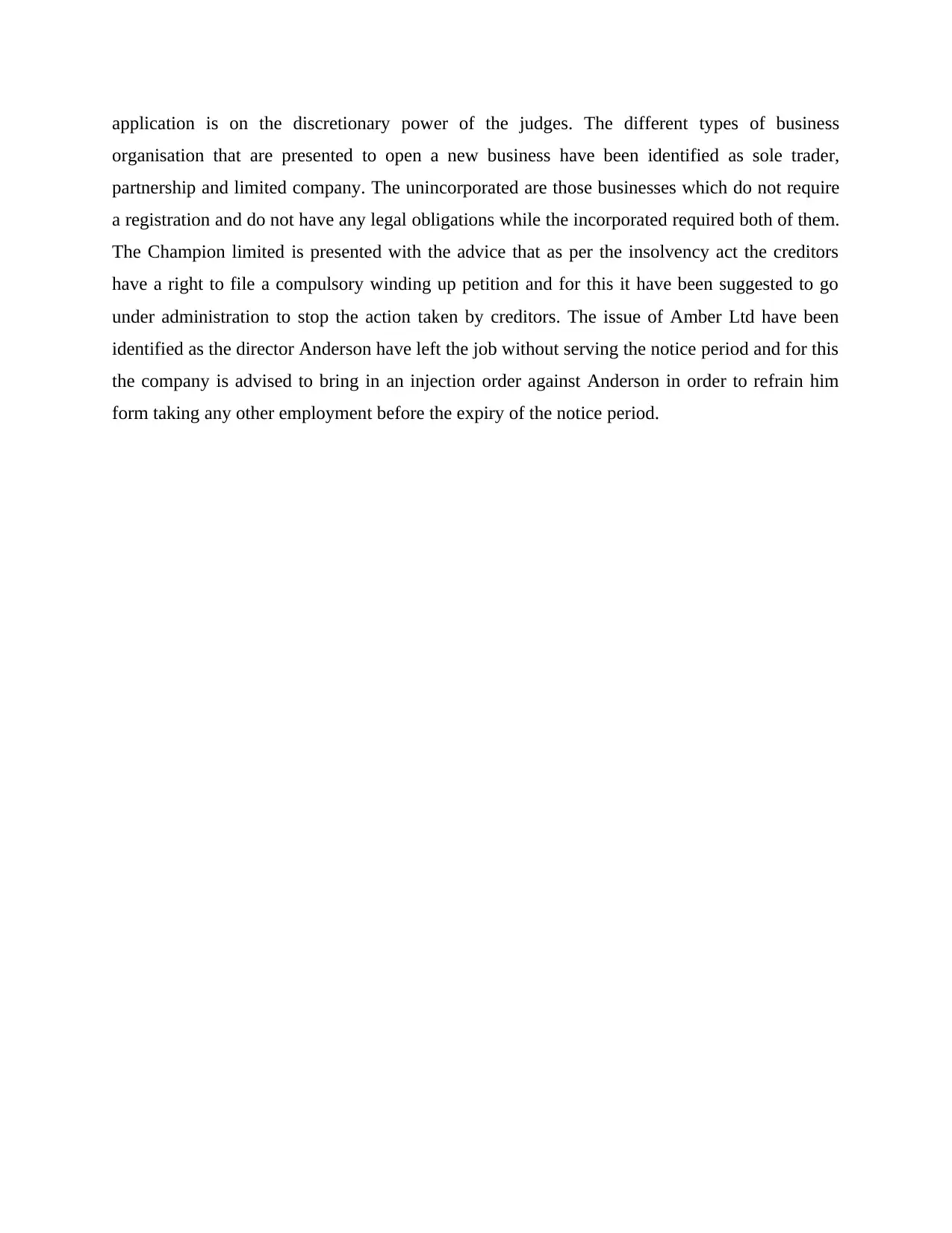
application is on the discretionary power of the judges. The different types of business
organisation that are presented to open a new business have been identified as sole trader,
partnership and limited company. The unincorporated are those businesses which do not require
a registration and do not have any legal obligations while the incorporated required both of them.
The Champion limited is presented with the advice that as per the insolvency act the creditors
have a right to file a compulsory winding up petition and for this it have been suggested to go
under administration to stop the action taken by creditors. The issue of Amber Ltd have been
identified as the director Anderson have left the job without serving the notice period and for this
the company is advised to bring in an injection order against Anderson in order to refrain him
form taking any other employment before the expiry of the notice period.
organisation that are presented to open a new business have been identified as sole trader,
partnership and limited company. The unincorporated are those businesses which do not require
a registration and do not have any legal obligations while the incorporated required both of them.
The Champion limited is presented with the advice that as per the insolvency act the creditors
have a right to file a compulsory winding up petition and for this it have been suggested to go
under administration to stop the action taken by creditors. The issue of Amber Ltd have been
identified as the director Anderson have left the job without serving the notice period and for this
the company is advised to bring in an injection order against Anderson in order to refrain him
form taking any other employment before the expiry of the notice period.
⊘ This is a preview!⊘
Do you want full access?
Subscribe today to unlock all pages.

Trusted by 1+ million students worldwide
1 out of 13
Related Documents
Your All-in-One AI-Powered Toolkit for Academic Success.
+13062052269
info@desklib.com
Available 24*7 on WhatsApp / Email
![[object Object]](/_next/static/media/star-bottom.7253800d.svg)
Unlock your academic potential
Copyright © 2020–2025 A2Z Services. All Rights Reserved. Developed and managed by ZUCOL.




